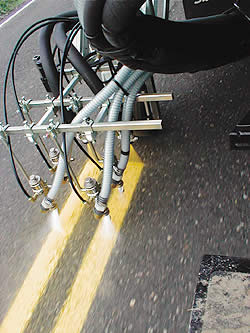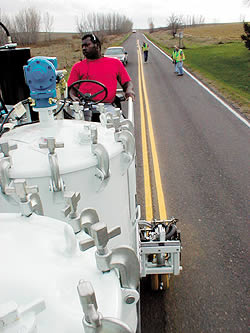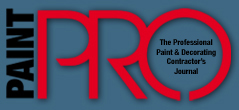
Parking Lot Striping, Traffic Paint
Waterborne vs. solvent paint — In the broadest of terms, there are two basic types of traffic paints: waterborne and solvent based. Overall, waterborne is more prominent for long stripers while solvents are preferred by many in the parking lot business.
by David Thompson
to expand your business and don’t mind working at night, parking lot painting could be the answer. It’s more of a paint-by-numbers gig where there’s not much wiggle room for creativity, but it’s a job that needs to be done year after year, time after time.
Assuming a contractor already has his own truck and trailer, he could purchase startup equipment for, generally, between $5,000 and $10,000. “A good small air atomized machine is about $2,500 and an airless unit is about $3,500, with about another $1,000 for stencils, measuring devices and layout chains,” estimates Felton Smith, director of research and development for traffic paint for Ennis Paint, a major manufacturer headquartered in Ennis, Texas. Smith has been with the business for the past 40 years.
Don Vermeer, director of sales and marketing for Vogel Traffic Services in Orange City, Iowa, the company responsible for EZ-Liner stripers and Vogel traffic paints, agrees that contractors should be prepared to invest about $5,000 at the minimum for entry-level equipment, “but they should be prepared to invest another $3,000 to $5,000 more in stencils, cones, extra tips and a broom machine.”
To help keep the price down, there is lots of used equipment available, Smith points out. And whereas you could get started in the parking lot painting business for a few thousand dollars, the road-marking long-line business is another story.
“A truck alone runs between $100,000 and $500,000,” Smith says, adding that it’s not a business that you can break into easily. “DOTs are looking for financial responsibility, experience and quality work.” And to achieve those requirements, you have to start out small and work your way up. Railroad crossing and rest stop jobs are a good place to start.

Nationwide, Smith estimates, 35 million gallons a year are used to mark roadways in the United States. Parking lots, on the other hand, only consume about 3 million gallons total.
Road marking paint is white or yellow, but there are other colors available for special applications. Red is for fire lanes, blue denotes handicap and green signals a military crosswalk or bicycle crossing. Regardless of the color, though, it’s a fast-dry product, taking anywhere between 30 seconds and 30 minutes to dry.
There are two levels of dryness, says Tom Wood, national sales manager for Sherwin-Williams highway products. “There’s ‘dry, no pickup’ — the amount of time it takes paint to develop a skin so a tire won’t pick up any paint when it rolls over it. And there’s ‘dry-through,’ where the paint is completely dry.”
“Dry-through is the time required to dry hard to a mar-resistant state,” Smith reiterates. “Most parking lots need to be closed for two hours to achieve this stage and prevent line marring with tire prints and dirt retention. But technically, waterborne products need three hours at about 50 degrees F to be totally cured.”
Paint applied on public roadways, which is typically faster drying than paint used in parking lots, often is embedded with glass beads to give the painted lines a retroreflective quality. The paint itself is not reflective, Smith says.
“Light hits the beads and it bounces back toward its source [rather than away from it],” Vermeer explains. “You see the paint at nighttime because of the glass beads.”
Beads, however, are rarely needed in parking lot applications because the lots are constantly lit by overhead lights.
|

